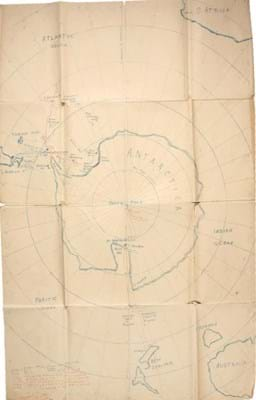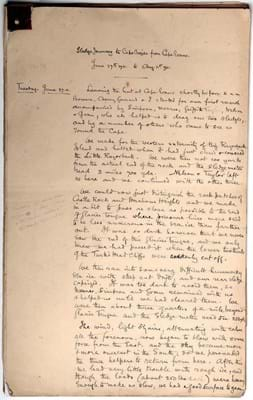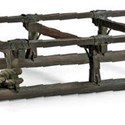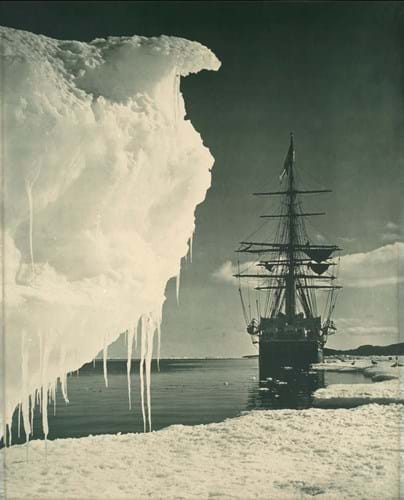
One of the most celebrated of all the images taken during Captain Scott’s last expedition, The Terra Nova at the Ice-Foot, Cape Evans was taken by Herbert George Ponting on January 18, 1911. At the time, Bond Street gallery The Fine Art Society sold Ponting’s photographs in four sizes priced between 10s.6d and £2.2s.0d each. At 2ft 6in x 23in (75 x 58cm), this copy, sold at Bonhams in 2019 for £8000, is in the largest format.
The collecting of books, manuscripts and artefacts connected with polar exploration is now a well-established area.
Indeed, over the last 20 or 30 years some of the highest prices seen in the salerooms for 20th century historical material have been for polar-related items.
But for a long time, this was not the case.
The story of Robert Scott and Roald Amundsen’s race to the South Pole, and the heroic failure of the British expedition as portrayed in the 1948 film Scott of the Antarctic, had been enshrined in popular mythology for several decades before the collecting world began to sit up and take notice.
Back in 1948, the venerable London dealership Maggs was offering a letter from Scott to Florence Nightingale for just £3.50. In 1953, when Sotheby’s offered a set of Shackleton’s 1907 South Polar Times the winning bid was £12.
Values did increase slowly, slightly accelerating in the 1970s when some of the explorers or their families began to sell material, but you could still pick up a Scott autograph manuscript for £350 in 1974.

Bonhams’ 2012 Scott and Amundsen Centenary Sale included one of Scott’s ‘farewell letters’, torn from the notebook found in his tent. Then sold for £135,000, it took £330,000 when offered again in the same rooms in November 2022.
The catalyst
It was only in the 1990s that things changed. The catalyst was a series of sales at Christie’s.
Rather ironically, the origin of these sales lay in a single-owner collection of material from the opposite end of the temperature scale: a joint venture to sell material from the subcontinent that brought together Christie’s watercolour department and its book department, under the auspices of Tom Lamb.
The success of the Visions of India sales prompted Lamb’s realisation that collectors really wanted “the whole gamut of prints, pictures, books, artefacts and photographs”.
In 1996 he established the Exploration and Travel sale with Nicholas Lambourn and soon, encouraged by members of the trade, they hit on the idea of a devoted Polar sale. It was, Lamb recalled, “a field which did not appear to have much material coming to the market, but one in which the prices were rising fast!”.
Scott suitcase ‘holy grail’
One of the best sales over that decade was the Scott ‘relics’ sale.
“Mrs Scott invited us to sell a small suitcase of material, one of three taken out of the hut”, says Lamb. “Every scrap was catalogued as a separate entity, 60 lots in all, a packed saleroom of 100 people, and an atmosphere that you could cut with a knife.
“These were part of the collecting holy grail, the other two suitcases now being at the Scott Polar Research Institute [SPRI]. Numerous records were made that day, for a biscuit, for a housewife [sewing kit] and for a Scott photograph.”
The single Huntley & Palmers ‘sledging biscuit’ sold for £3100 received the most headlines although two of the highest prices were for a silver cigarette box presented by Scott to Ernest Shackleton and Scott’s sledging flag (both £28,000).
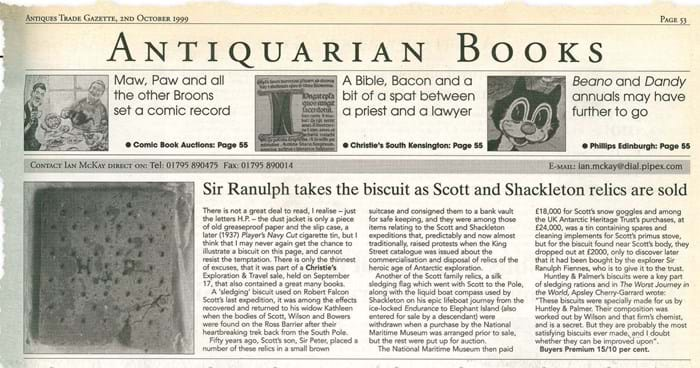
How ATG reported the Scott ‘relics’ sale at Christie’s in September 1999. A single Huntley & Palmers ‘sledging biscuit’ sold for £3100 provided the illustration.
In 2002 it was Shackleton’s turn, his family working with SPRI to select a range of pieces that they felt would appeal without leaving too many holes in the collection.
It was an unusual but pragmatic and very successful collaboration.
There were over 150 lots of books, letters, photographs and artefacts – and again a packed saleroom.
With other explorers and their families following suit, the designated Polar sales continued for some 10 years and were a huge success, establishing numerous world records and attracting a new audience for everything from watercolours to exhibition crockery.
Bonhams adopted the format for the 2012 Scott and Amundsen Centenary Sale, the highlight of which was one of Scott’s ‘farewell letters’, torn from the notebook found in his tent. This sold for £135,000, and it’s a testament to the growth in values that the same letter went on to sell for £330,000 when it was offered once more at Bonhams in November 2022.
Library centrepieces
The core of any polar collection is usually the library.
And the centrepiece for any collector is likely to be the 1908-09 Aurora Australis, edited by Shackleton and printed and bound in Antarctica under extraordinary circumstances.
Some 65 copies have been accounted for, one of which hammered at a fraction under £100,000 in 2015.
Copies of the standard works by Scott, Shackleton and other contemporaries are easier to come by, and a good place to start for any budding collector.
Inevitably, however, a huge gulf in value has emerged between ‘ordinary’ and exceptional copies.
Often the latter might comprise inscribed or association copies, but some of the highest prices have been reserved for fine copies in the very rare dust-jackets. An ‘outstanding’ jacketed copy of Cherry Garrard’s The Worst Journey in the World, from the library of the well-known collector Marty Greene, sold for £19,000 at Bonhams in 2012, eclipsing the £15,000 paid for a jacketless copy which was inscribed to Scott’s mother and had her marginalia correcting inaccuracies.
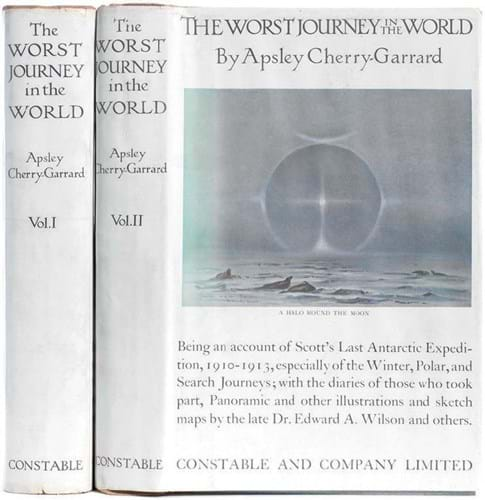
An ‘outstanding’ jacketed copy of Cherry Garrard’s The Worst Journey in the World, from the library of collector Marty Greene, sold for £19,000 in Bonhams’ 2012 sale.
In 2015 the extraordinary Franklin Brooke-Hitching sales at Sotheby’s told a similar story.
Two issues of Scott’s Voyage of Discovery in dust-jackets sold for more than any inscribed copy. These books are often illustrated with photographs by Herbert Ponting or Frank Hurley, whose spectacular large original prints and album collections are highly prized and deserve a special mention. A newly discovered Hurley album with 79 photographs of the Weddell Sea Party reached £70,000 at Bonhams in 2020.

One of 79 photographs from a newly discovered Frank Hurley album depicting the Weddell Sea Party during the Imperial Trans-Antarctic Expedition of 1914-17 sold for £70,000 at Bonhams in 2020.
Expedition artefacts
Many of the auction highlights of recent years have instead been original manuscripts and artefacts from the expeditions themselves.
In 2022 a map of Antarctica drawn by Shackleton sold at Sotheby’s for £140,000 (it had made just £6000 in 1991); and in 2009 Edward Wilson’s manuscript report on the celebrated winter journey to the emperor penguin rookery at Cape Crozier went for £110,000 at Bonhams.
Ten years later a sledge retained by Eric Marshall from the first Shackleton expedition was bought by the National Maritime Museum in the same rooms for £115,000, after being the subject of an export block.
Gallant captain
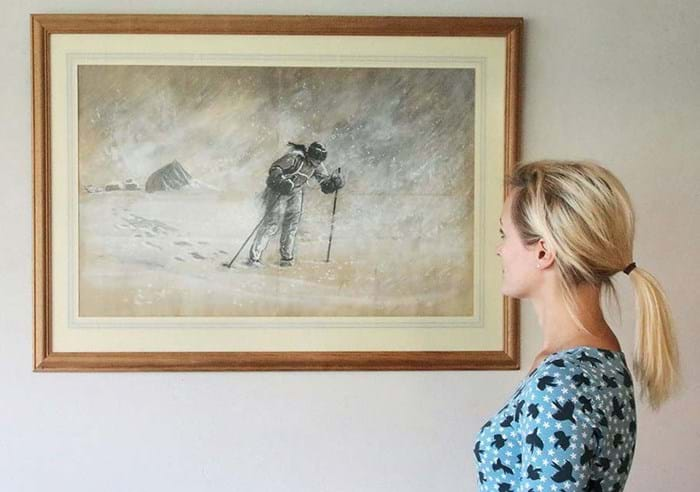
Executed in pen, ink and watercolour heightened with white, this sketch of Oates walking to his death by John Charles Dollman (1851-1934) sold for £23,000 at Sworders in September 2020. The finished picture painted in oils titled A Very Gallant Gentleman hangs in the Cavalry Club, London. It was commissioned by officers of the Inniskilling Dragoons in 1913 as news arrived of the doomed Terra Nova expedition and shown at the Royal Academy that year.
The story of Captain Lawrence Oates is one that resonates particularly deeply. A sketch for the painting A Very Gallant Gentleman by John Charles Dollman (1851-1934) that depicts Oates walking to his death in 1912 sold for £23,000 at Sworders in 2020.
At a more modest £4500, books dealership Maggs is currently offering a portrait of Captain Oates and two letters exchanged between the bereft crewmates Edward Atkinson and Francis Davies.
Maggs’ Polar specialist Fuchsia Voremberg notes: “Oates’ self-sacrifice has a kind of mythic place in the British consciousness, but the thing I find most moving about it is the way it was cited in the parliamentary case for the decriminalisation of suicide.”
All manner of objects
Other collectable items to have survived and appeared in the salerooms include ice picks, cutlery, dining ware, flags, cartridge bags, clothing, goggles, medicine chests and all manner of objects from the various ships or the shore expeditions. Cast-iron provenance is always key.
Hence a penguin egg brought back by Francis Davies on the Terra Nova sold for £2000 at Exeter auction house Bearnes Hampton Littlewood in 2021, and a stuffed penguin presented by the ship’s doctor which fetched £8000 at Sworders of Stansted Mountfitchet, Essex, in 2020, finding a home at the Canterbury Museum in Christchurch, New Zealand.
Earlier explorers
Of course, the history of polar exploration did not begin in the 20th century.
The discovery of South Georgia dates back to 1675, and the first properly documented landing on the mainland of Antarctica was by the appropriately named Mercator Cooper in 1851-53.
Far fewer 19th century artefacts understandably come to light, but books relating to the expeditions of James Weddell, George Nares, Carsten Borchgrevink and James Clark Ross are very collectable.
No complete set of reports of the latter’s expedition to determine the South Magnetic Pole (The Zoology of the Voyage of HMS of Erebus and Terror, published 1844-75) has been traced, but a substantial portion sold at Sotheby’s in 2017 for £35,000.
As a general rule, Arctic exploration and the search for a Northwest Passage do not get quite so much attention in British consciousness. In this field Canadian institutions and buyers are more active.
However, the general principles apply in terms of collecting.
Books on the many expeditions are very collectable, and original manuscript material much more so – one highlight in recent years was the illustrated journal kept by Albert Markham during Nares’ British Arctic Expedition, recording the sledge journey on which he achieved the record of Farthest North (Bonhams, 2015, £85,000).
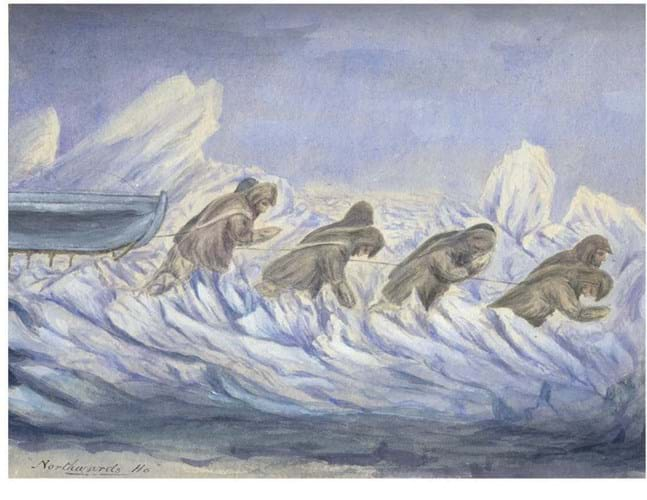
A watercolour from the illustrated journal kept by Commander Albert Hastings Markham (1841-1918) during Sir George Strong Nares’ British Arctic Expedition of 1875-1876. The expedition failed in its objective to reach the pole but a sledging party under Markham achieved the record of Farthest North. The journal sold for £85,000 at Bonhams in 2015.
In 2022 Sotheby’s sold a flag which accompanied Amundsen on several polar expeditions for £70,000. It might justly claim to be the only object from that era to have been to both the South and North Poles.
Research continues to settle the mystery of who discovered the North Pole – Robert Peary in April 1909 or perhaps Frederick Cook a full year earlier. And new discoveries do make a difference to the market.

This Norwegian flag accompanied Roald Amundsen on several polar expeditions in the years 1903-26 and flew at both North and South Poles. In May 2022 it sold at Sotheby’s for £70,000.
Latest developments
According to Fuchsia Voremberg at Maggs, the book trade is seeing a shift owing to environmental concerns and recent events.
“The discovery of the wreck of Endurance has brought the stories of the Heroic age of Antarctic exploration back into the mind of the public, and we’ve seen a lot of interest in Sir Ernest Shackleton particularly.
“Equally as the climate crisis worsens year by year, the history of human engagement with the polar regions has taken on a new resonance. It used to be about celebrating feats of bravery and endurance, whereas now the impression I get from a lot of collectors is that they are just as interested in these books and artefacts for the record they hold of the endangered polar environments.”
It has also become possible for wealthier collectors to now travel to Antarctica and see at first hand some of the places it has previously only been possible to read about or see on television. On the big screen beautifully restored versions of Hurley’s film South and Ponting’s The Great White Silence have kept their stories very much alive.
Institutional interest
Another important factor in the strength of the market is the role that museums and institutions have played over the past two decades, bringing the subject to a wider audience.
SPRI, the National Maritime Museum, and the Dundee and Canterbury museums have been very actively acquiring material through donations and purchases.
A Heritage Fund report in 2020 noted: “SPRI has developed new and existing external relationships with auction houses and collectors, and with the descendants of those involved in the Shackleton expedition. The institute found that as Shackleton-related items passed through generations, owners felt a diminishing sense of attachment as any familial connection with the expedition was diluted. This meant owners were more likely to view items as assets rather than treasured possessions.”
One of the SPRI’s most important acquisitions was the collection of 113 photographic negatives taken by Scott on the fateful last expedition. These were bought for £275,000, most of which came from the National Heritage Memorial Fund, the remainder from a fund-raising appeal backed by Sir Ranulph Fiennes.
As a partial result of these increased efforts to acquire ‘primary’ material from the families of explorers and elsewhere, when a good collection does come onto the auction market, competition is fierce.
But material can still be found, and at prices to suit all pockets. A case in point was the 2021 Francis Davies Terra Nova and maritime archive offered by Bearnes, Hampton & Littlewood, with prices ranging from under £100 up to £10,000.
Diminishing supply
Looking forward, the supply of material does seem certain to diminish and the demand continue to increase, although some of the private collections of the 1990s and early 2000s may come back onto the market at some point.
In the meantime, institutions such as SPRI continue to lead the way with research, training and education projects, helping to inspire the next generation of scientists, explorers and perhaps collectors. After all, no other field is so inextricably linked to the future of their planet.
Simon Roberts is head of sale for Bonhams’ Books, Maps & Manuscripts department in London.


